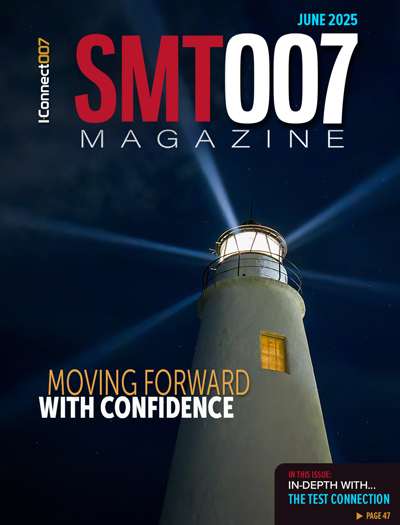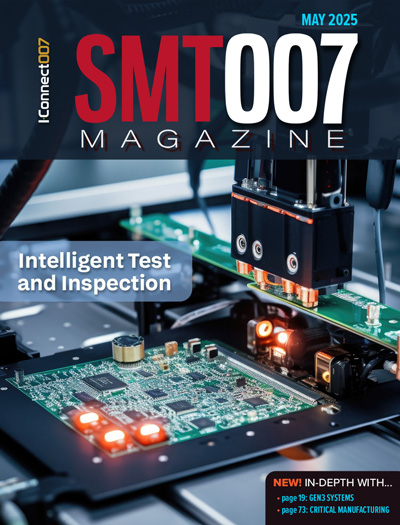-

-
News
News Highlights
- Books
Featured Books
- smt007 Magazine
Latest Issues
Current Issue
What's Your Sweet Spot?
Are you in a niche that’s growing or shrinking? Is it time to reassess and refocus? We spotlight companies thriving by redefining or reinforcing their niche. What are their insights?

Moving Forward With Confidence
In this issue, we focus on sales and quoting, workforce training, new IPC leadership in the U.S. and Canada, the effects of tariffs, CFX standards, and much more—all designed to provide perspective as you move through the cloud bank of today's shifting economic market.

Intelligent Test and Inspection
Are you ready to explore the cutting-edge advancements shaping the electronics manufacturing industry? The May 2025 issue of SMT007 Magazine is packed with insights, innovations, and expert perspectives that you won’t want to miss.
- Articles
- Columns
- Links
- Media kit
||| MENU - smt007 Magazine
Foxconn's Tiger Leap Combining Nature and Technology in Ecological Roof Garden
April 23, 2025 | FoxconnEstimated reading time: 4 minutes
Hon Hai Technology Group, the world's largest technology manufacturing and service provider, has actively responded to the United Nations Sustainable Development Goals (SDGs). In recent years, it has continued to optimize the campus environment around the world and used the Tiger Leap Group Headquarters in Tucheng, New Taipei City as a demonstration base to create a "Smart Green Ecological Roof Garden" that combines nature and technology and has ecological, environmental protection and carbon reduction benefits. The coffee grounds produced in the factory are also turned into treasure and provided to local small farmers for use as compost, establishing an ecological cycle of community resources.
The Tucheng Huyue Headquarters, which has a history of more than 30 years, is an important base for the group's daily operations and customer NPI (New Product Introduction). Its rooftop solar system has been upgraded since October 2023. It uses more efficient solar modules, and the installation capacity has been expanded from 63.6 kwp to 716.9 kwp. The power generation in the first year is approximately 849,000 kWh, an increase of 18 times. It can provide all lighting electricity in the factory and reduce carbon emissions by approximately 419 tons each year. The accompanying solar energy monitoring system can obtain big data information such as solar module and inverter operation, power generation, weather, sunshine intensity, etc. in real time, and present environmental contribution, such as carbon reduction and other environmental protection data, so that colleagues can understand the company's efforts on the net zero path, which is an important part of internal education and training.
The green energy transformation of the roof of the Huyue Factory specially adopts a trellis solar energy system. The solar module is designed to be elevated, and the lowest point is still 2.3 meters, retaining a walkway for employees to rest and walk. The group's general affairs team then planted edible landscapes to create an aerial friendly farm, allowing colleagues to participate in planting and harvesting fruits and vegetables. To date, passion fruit, strawberries, tomatoes, basil, etc. have been produced. The roof has now become a popular place for employees to rest and relax in the factory. By fully covering the roof with solar panels and vegetation, the heat absorption temperature of the building is reduced, effectively reducing the power consumption of air conditioning.
In order to better handle and transform the waste within the factory, the NbS (Nature-based Solutions) system module was introduced to the Sky Farm: red earthworms were introduced to digest the dead branches and leaves and raw kitchen waste within the factory, and the resulting earthworm manure was returned to the farm, forming a natural closed-loop ecosystem of organic fertilizer; the factory also turned the 317 kilograms of coffee grounds produced each month into treasure, and provided them to small farmers in Tucheng District for use as compost.
"World Earth Day is our annual self-examination point and starting point, not the end point," said Hon Hai Technology Group's Chief Environmental Officer, Hong Rongcong. "The circular economy is one of the two core environmental strategies of the group. We not only have a 'closed-loop self-sufficiency', but also expand the 'external cycle' outside the factory to strengthen the connection with the organization where the factory is located. In the future, we will also further evaluate the reuse of common waste materials such as coffee grounds through industry-university cooperation, expand the implementation of the group's commitment to society and the environment, and continue to promote the concept of 'sustainable management = EPS+ESG'."
"As a demonstration site for the group's green and sustainable development, Tiger Leap headquarters uses electric buses for commuting and daytime shuttle service, and has installed supporting measures such as charging stations. At the same time, we reduce the use of disposable plastics, recycle kitchen waste, use local seasonal ingredients, and create green catering, allowing Tiger Leap's employee cafeteria to obtain environmentally friendly restaurant certification last year. In the future, we will gradually expand to Tucheng and other plants in Taiwan to provide employees with a friendlier and more environmentally friendly working environment." said Liang Lixin, senior director of the Central General Affairs Department of Hon Hai Technology Group.
As a demonstration base for Foxconn's internal environmental education and training, Foxconn Tiger Leap has display billboards in various facilities on the rooftop, and an observatory sign on the fifth floor that introduces the surrounding wetlands and other ecological natural environments, as well as the topography of the Linkou Plateau and Guanyin Mountain around the Taipei Basin. The lobby on the first floor of the headquarters has a vegetation wall and displays the Foxconn logo made of 3D printing from construction waste. Together with the signs for the algae reef and sustainable ocean project, a small biodiversity education venue has been created. The UL2799 zero waste certification sign and two environmental information promotion electronic signs set up in the restaurant also allow employees to learn about the group's sustainable efforts while dining and relaxing, integrating environmental education into daily work and life to build the group's overall environmental protection and carbon reduction culture.
Suggested Items
Bell to Build X-Plane for Phase 2 of DARPA Speed and Runway Independent Technologies (SPRINT) X-Plane Program
07/09/2025 | Bell Textron Inc.Bell Textron Inc., a Textron Inc. company, has been down-selected for Phase 2 of Defense Advanced Research Projects Agency (DARPA) Speed and Runway Independent Technologies (SPRINT) X-Plane program with the objective to complete design, construction, ground testing and certification of an X-plane demonstrator.
Toni Patzner Becomes Global Head of Supply Chain Management at ASMPT SMT Solutions
07/01/2025 | ASMPTOn June 1, 2025, Toni Patzner assumed the position of Global Head of Supply Chain Management. The experienced manager succeeded Jörg Cwojdzinski, who retired after decades of service.
Scanfil Signs New Customer and Starts Manufacturing Control Units for Emerson
06/19/2025 | ScanfilScanfil and Emerson signed an agreement concerning the Rosemount Tank Radar for Advanced Level Measurement Solutions. Emerson is a global technology, software and engineering company domiciled in the USA.
Flex CEO Sees US Manufacturing Resurgence
06/18/2025 | I-Connect007In a June 16 interview on Bloomberg Open Interest, Flex CEO Revathi Advaithi said the supply chain is already shifting, with more goods now being manufactured in the U.S.
Hon Hai Research Institute Achieves Breakthrough in Quantum Cryptography Recognized by Leading Global Conference
06/17/2025 | FoxconnHon Hai Research Institute (HHRI), the research arm of Hon Hai Technology Group (Foxconn), the world’s largest electronics manufacturer and technology service provider, has achieved a significant breakthrough in quantum computing.


